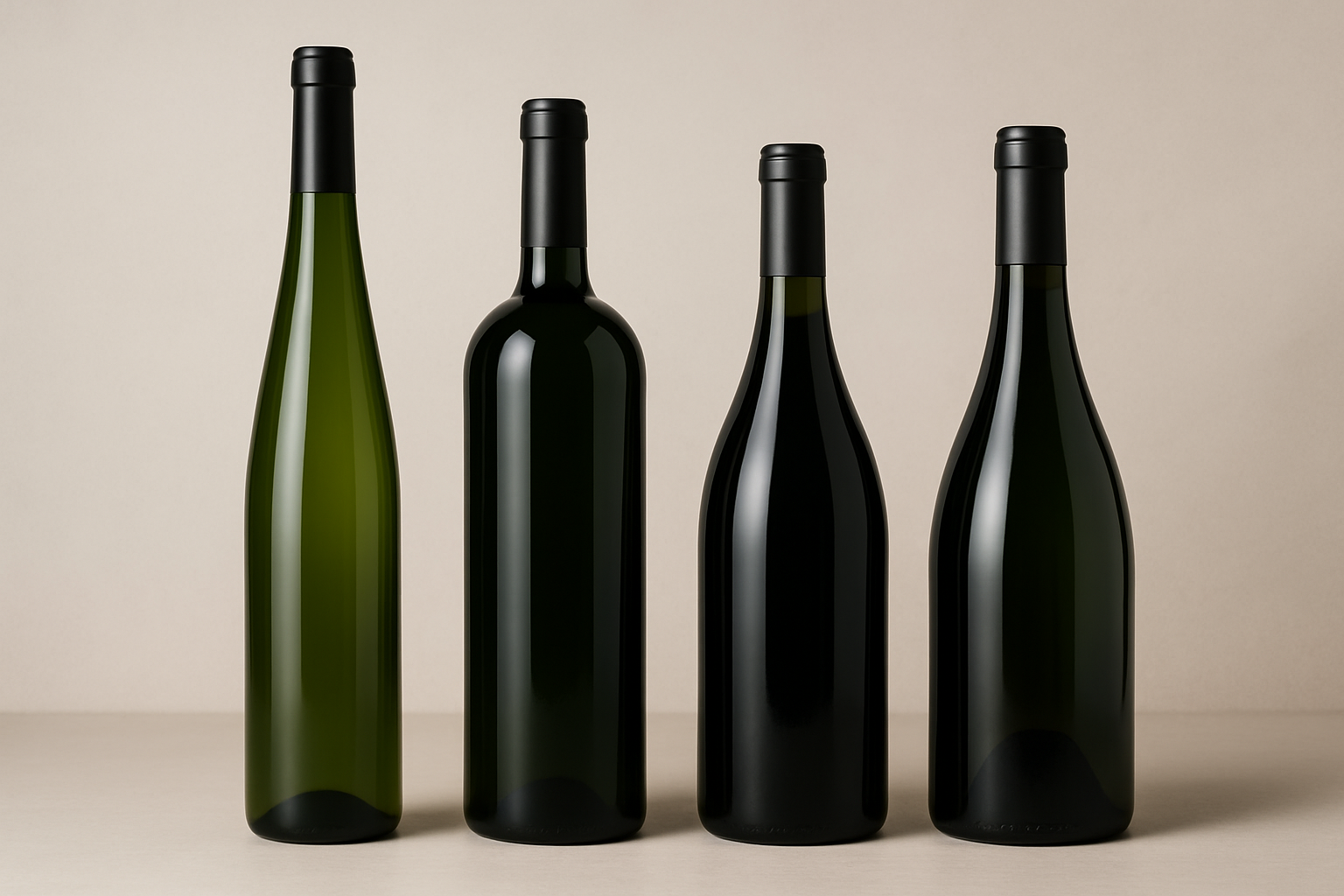
The Guide to Wine Bottle Shapes: Bordeaux vs. Burgundy vs. Hock
Wine Bottle Shapes Actually Matter (More Than You Think)
I'll admit it, I used to think a bottle was just a bottle. Then I started working with wineries. After years of helping clients choose packaging, I’ve learned that wine bottle shape isn’t just a cosmetic choice as it can affect everything from aging and storage to sales and perception.
Just recently, a winery called in a panic. They'd ordered 2,000 Bordeaux bottles for their Pinot Noir and were suddenly second-guessing the decision: “Should I have used Burgundy bottles instead?”
It’s a great question and one we get all the time. So, let’s break it down.
Why Wine Bottle Shape Matters for Winemakers and Brands
Here’s what choosing the right wine bottle shape actually impacts:
-
Wine Aging: Different bottles create different aging environments. I’ve literally tasted the same wine in Bordeaux and Burgundy bottles after five years and noticed real differences.
-
Consumer Expectations: Shape signals style. A Riesling in a Bordeaux bottle? That’ll confuse people.
-
Storage & Shipping Costs: Shapes affect how efficiently bottles pack and stack.
-
Pourability: Some bottles just pour better which is crucial for restaurants and tasting rooms.
The 3 Main Types of Wine Bottles (and When to Use Each)
1. Bordeaux Bottles – Straightforward, Efficient, Classic
These are the tall bottles with straight sides and strong shoulders. They're the go-to shape for many wineries and not without reason.
Best For:
-
Cabernet Sauvignon
-
Merlot
-
Malbec
-
Cabernet Franc
-
Sauvignon Blanc
-
Semillon
Why Winemakers Love Them:
-
The shoulders help trap sediment.
-
They stack efficiently, lowering storage and shipping costs.
-
They’re the most budget-friendly option.
Popular Colors:
-
Antique Green for red wines (UV protection)
-
Flint for showcasing white wine color (with caution)
-
Champagne Green as a versatile middle ground
📦 Pro Tip: These are the most efficient bottle shape for logistics and typically the most affordable to produce.
2. Burgundy Bottles – Elegant and Ideal for Delicate Wines
With gently sloped shoulders and a wider base, Burgundy bottles don’t just look premium, they serve a purpose.
Best For:
-
Pinot Noir
-
Chardonnay
-
Syrah
-
Pinot Grigio
Why They Matter:
-
Designed for wines with nuanced aromatics
-
Usually feature deeper punts for grip and structure
-
Perceived as more upscale (which can allow for higher pricing)
Color Options:
-
Champagne Green (traditional)
-
Antique Green (rich reds)
-
Flint (whites, especially barrel-aged)
💡 Watch Out: Burgundy bottles take up more space about 15–20% more in some cellars.
3. Hock Bottles – Tall, Sleek, and Show-Stopping
Hock bottles come from the Rhine region and are often associated with Germanic varietals.
Best For:
-
Riesling
-
Gewürztraminer
-
Albariño
-
Moscato
-
Any aromatic white wine
Why Choose Them:
-
Elegant and tall, they stand out on shelves
-
Traditionally used for wines that shine in color and clarity
Color Choices:
-
Amber for tradition and UV protection
-
Flint to show off clarity (great for DTC sales)
-
Cobalt for premium eye-catching shelf appeal
⚠️ Heads-Up: These bottles are typically the tallest and the most expensive.
How to Choose the Right Wine Bottle Shape (Step-by-Step)
🥂 Step 1: Match Shape to Wine Style
-
Big, bold red? → Go Bordeaux
-
Delicate Pinot or Chardonnay? → Burgundy
-
Aromatic or off-dry white? → Hock
🛒 Step 2: Think Like a Customer
-
Retail shelf presence? Hock or Burgundy stand out.
-
Traditional markets? Bordeaux is a safe, trusted option.
-
Premium perception? Burgundy bottles subtly signal quality.
🧠 Step 3: Be Practical
-
Tight storage? Bordeaux wins for space efficiency.
-
Shipping DTC? Stick with shapes that are easier to pack.
-
Restaurants or tasting rooms? Burgundy bottles are easier to grip and pour.
What About Bottle Color?
Color isn’t just aesthetic—it plays a big role in protecting your wine and influencing perception.
|
Color |
UV Protection |
Ideal For |
|
Antique Green |
High |
Red wines, traditional look |
|
Champagne Green |
Moderate |
Versatile, clean appearance |
|
Flint (Clear) |
Low |
Whites and rosés (indoor storage) |
|
Amber |
Very High |
Germanic wines, Riesling |
|
Cobalt |
Premium look |
Limited editions, luxury branding |
🔒 Rule of Thumb: If your wine hits retail shelves, avoid Flint unless you're sure it won’t get UV exposure.
Cost Factors: What Drives Bottle Pricing?
-
Shape Complexity: Hock = most expensive
-
Color Choice: Specialty colors like cobalt cost more
-
Glass Weight: Thicker = more protection and prestige (but pricier)
-
Order Size: Most suppliers require pallet quantities (400–600 bottles)
⏱️ Lead Times: Plan for 4–6 weeks for standard bottles, 8–12 weeks for custom runs (and longer during harvest).
Sustainability Trends in Wine Packaging
-
Lightweight Bottles: Lower carbon footprint + shipping cost savings
-
Glass Recycling: All shapes are recyclable—but check local guidelines
-
Reuse Programs: Bordeaux bottles are ideal for reuse due to durability
♻️ Sustainability isn’t a fad, it’s a smart long-term move.
Common Mistakes to Avoid
-
❌ Switching bottle shapes between vintages (confuses customers)
-
❌ Ignoring closure compatibility (not all corks fit all shapes)
-
❌ Choosing based on looks alone (without considering aging or shipping)
-
❌ Overlooking storage space (especially with Burgundy bottles)
Frequently Asked Questions
Q: Can I use any bottle shape for any wine?
Technically yes, but practically? Not a good idea. Customers expect certain wines to come in familiar shapes.
Q: Which shape is best value?
Bordeaux bottles win on price, space, and availability.
Q: Can bottle shape impact aging?
Yes—especially Bordeaux bottles for reds that throw sediment.
Q: Are different colors OK for the same wine?
Only if there’s a clear, customer-facing reason (e.g., reserve bottling vs. standard).
Q: Do bottle shapes affect shipping costs?
Absolutely. Bordeaux bottles are the most shipping-friendly.
Final Thoughts: Choose the Bottle That Tells Your Story
Your wine bottle isn’t just a container, it’s part of your story. It affects how your wine is perceived, how it ages, and how smoothly your business runs.
If you're still unsure, that’s normal. Our team has helped hundreds of wineries find the right bottle shape for their goals and we’d love to help you too.
👉 Explore our full selection of wine bottles in Bordeaux, Burgundy, and Hock shapes
👉 Contact us for personalized recommendations based on your varietal, budget, and production plans.
